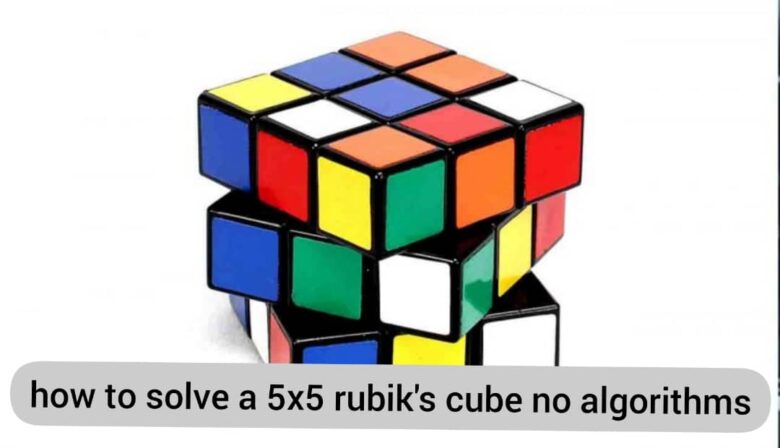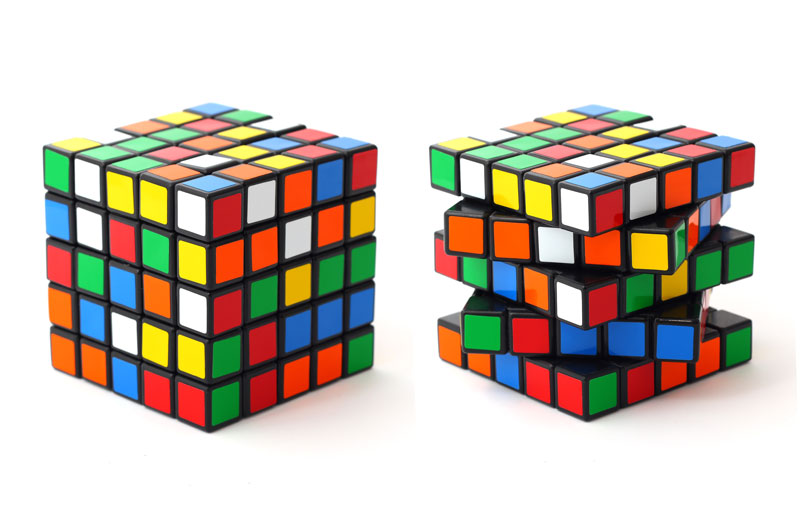How to Solve a 5x5 Rubik's Cube With Pictures

how to solve a 5×5 rubik's cube no algorithms
Hello, welcome to solsarin site. We're glad you chose our site for the information you've been looking at. Our goal is to educate and answer your questions in this post we want to find out"how to solve a 5×5 rubik's cube no algorithms"
Stay with us🌹
Step 1: My Collection/experience
I started cubing over the summer of 2007. I got a dollar store "magic" cube, which was a cheap Rubik's cube. It came with instructions, which I memorized, and have now fine tuned so I can solve my cube with a 12 cube average of 51 seconds.
Step 2: My Solve
This is a video of me solving the cube using my solution. I have only been solving this since christmas, so a couple weeks and I dropped my time by about 20 minutes. I took a long time to solve it the first few times, because I was still learning algorithms. Now, my time is below 10 minutes.
By the way, that cube is not the one I am using in my instructions, its the Rubik's one.
Step 3: Getting Started
Ok, so the first step is to get your cube mixed up (I assume you have already done so, which is why you are reading this in the first place)
Step 4: Notation
In the image below, you will see the notation I will be using. It is standard 5×5 notation, as far as I know. If just the letter is there, turn the face denoted clockwise, if you are looking at that side
' means counter clockwise.
I always solve my cube white centers first, then yellow, and the rest vary. It might help to follow how I am solving it if you start on white, then go to yellow, and work with my sides.
Getting Faster At 5×5
Full Advanced Big Cubes Playlist
5×5 advanced techniques are mostly intuitive, with very few algorithms.
There are no recommended times or goals for this, because it largely depends on your 3×3 skill. Unlike 3×3, you can learn them all relatively quickly. If you want to be good at 5×5, you should learn all of these. They are listed below in order of importance.
See also the following:
- jack daniels whiskey 80 proof
- how to find percentage decrease calculator
- how to calculate percentage of salt in water
- whiskey jack daniel's no.27 gold 700ml
- how much alcohol in bud select
Free Slice Edge Pairing
This technique used for all big cube solving methods.
Free Slice Edge Pairing solves the first 8 edges (out of 12 total edges) while keeping the centers unsolved.
This video also covers Reduction and Yau, which are the most popular methods on 5×5.
Part 1
Decoding the Rubik's Cube Shorthand
Remember that U, D, L, R, F, and B create the 6 cube faces. Hold your Rubik's cube in 1 hand, keeping the puzzle upright as you hold it. To have an easier time solving the puzzle, assign labels to all 6 faces. Label the top face as "Upper" (or "U"), the bottom face as "Down" (or "D"), the leftmost face as "Left" (or "L"), the rightmost face as "Right" (or "R"), the front face as "Front" (or "F"), and the back face as "Back" (or "B").
- Always keep the cube in the same position as you complete the puzzle, or else you won't be able to solve it properly.
2
Perform a ¼ clockwise turn when a single letter is shown. Grip the edges of a cube face and rotate it clockwise by 90 degrees. Use this small turn whenever the algorithm specifies a single letter.
- Unless specified, always perform a ¼ turn in a clockwise direction.
- For example: Imagine that the upper face is completely green, while the front face is completely red. Grab the edge of the front face and rotate it 90 degrees clockwise to perform a ¼ turn. At this point, 1 row of the green squares will now be visible of the right face of the cube.
3
Use a ½ clockwise turn whenever you see the number 2. Keep an eye out for algorithm shorthand that includes both numbers and letters. If you see a "2" immediately after a letter, rotate 1 face of the cube by a full 180 degrees. Keep in mind that ½ turns are also clockwise, unless the algorithm specifies otherwise.
- For instance: Pretend that the upper face of the cube is white, the right face is blue, the bottom/down face is orange, the left face is red, and the front face is green. If the algorithm says "F2," grip the front face of the cube and rotate it 180 degrees. Once you finish turning the front face, the bottom row of the upper face will be orange.
4
Do a counter-clockwise ¼ turn when you see an apostrophe ( ' ). Keep an eye out for stray apostrophes, as they can make your puzzle-solving experience much more difficult. While most algorithm steps require you to turn the cube clockwise, this punctuation requires you to turn the cube in the opposite direction. Double check all algorithms before you rotate anything so your puzzle doesn't get jumbled.
- For example: Imagine again that upper face is green, while the front face is red. Turn the front face 90 degrees to the left whenever you see an apostrophe listed in the algorithm (e.g., U', F').
- More often than not, counter-clockwise movements are used for ¼ turns, but not ½ turns.
5
Turn 2 columns at once when you see the letter "w." Rotate 2 columns 90 degrees to the right whenever you see a lowercase "w" next to a cube face (e.g., Rw, Uw). Since the Professor cube is much larger than its 3x3x3 counterpart, you'll need to rotate the cube in larger amounts in order to solve the puzzle.
- For instance, if a puzzle algorithm reads "Rw," perform a ¼ turn using 2 layers of the right face.
- If you see an apostrophe after the "w," be sure to turn the cube counter-clockwise.
6
Spin 3 columns together whenever you see the number 3. Keep your eyes peeled for an additional number included in the puzzle algorithm. Whenever you see the number "3," rotate 3 layers beneath the face specified in the algorithm.
- Depending on the algorithms you reference, you might not run into any instructions telling you to rotate 3 layers of the cube at once.

Part 2
Finding the Centers
1
Form a small cross with the F R' D' R F2 algorithm. To make the puzzle-solving process less overwhelming, start solving the centers of the large Rubik's cube. In this case, pretend that you're tinkering with a generic, 3x3x3 cube instead of the more complex puzzle. To start, try using the F R' D' R F2 algorithm to get a cross on the upper layer of the cube.
- This algorithm is most commonly used on 3x3x3 cubes. For more information on algorithms specific to 5x5x5 cubes, check out this resource
- Make sure that you have a center cross/plus sign in the middle of each cube face before continuing.
2
Find the centers using U' R' U R' U' 2R U. Begin filling in a solid 3x3x3 center on each cube face by rotating the upper layer of the cube in a counter-clockwise ¼ turn. Next, turn the right face of the cube in a counter-clockwise ¼ turn
- Take the algorithm one step at a time. If you think you've made a mistake, try turning the cube in the opposite direction that you just rotated it in.
3
Follow the U R' U' portion of the center algorithm. After completing the first 2 steps of the puzzle, continue by rotating the upper face of the cube in a clockwise ¼ turn. Next, turn the right face of the cube in a counter-clockwise ¼ turn. Finally, rotate the upper face again, but in a counter-clockwise ¼ turn.
- Pay close attention to the apostrophes in any Rubik's cube algorithm. The can be easy to miss!
4
Finish finding the centers with 2R U. Proceed by rotating the right face of the cube in a clockwise ½ turn. Next, complete the algorithm by turning the upper face in a clockwise ¼ turn.
- This is the only portion of the algorithm that involves a ½ turn.
Rubik's Cube
The Rubik's Cube is a combination puzzle invented in 1974 by Hungarian sculptor and professor of architecture Ernő Rubik. Originally called the Magic Cube, the puzzle was licensed by Rubik to be sold by Ideal Toy Corp. in 1980 via businessman Tibor Laczi and Seven Towns founder Tom Kremer. Rubik's Cube won the 1980 German Game of the Year special award for Best Puzzle. As of January 2009, 350 million cubes had been sold worldwide,[ needs update ] making it the world's bestselling puzzle game and bestselling toy.
How to Solve a 5x5 Rubik's Cube With Pictures
Source: https://solsarin.com/how-to-solve-a-5x5-rubiks-cube-no-algorithms/
0 Response to "How to Solve a 5x5 Rubik's Cube With Pictures"
Post a Comment